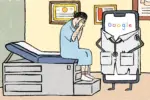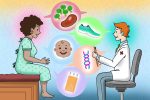Black bodies are often under surveillance. They have a history of being probed and treated as lab rats by medical scientists. They have a history of being public property, a history of being owned and abused. It is no surprise, then, that African Americans often confront the health care system with a sense of fear, dread, anxiety, disappointment and skepticism. They are at risk of losing their lives to medical ignorance and racism. For this reason, it is important to approach the reality of the doctor-patient experience with an understanding of the cultural prevalence of marginalized care experiences that center the patient as the pupil or slave and the doctor as the boss, teacher or slave-master.
Racism embeds itself into health care practices just as it does in the workplace, in government, in public health measures or public policy agenda-setting, in state apparatuses, in media, in educational institutions and in public and private spaces, venues or facilities in general. The American health care system needs to overhaul the practice of diminishing the African American patient experience if it is to reduce the disparities in medical care that plague the disenfranchised bodies and voices of silenced patients and preserve the integrity of medical science.
In the book “A Path to Healing: A Guide to Wellness for Body, Mind, and Soul,” Dr. Andrea Sullivan explores how, in part due to the legacy of racism in America, African Americans have inherited a deep distrust of doctors. This skepticism is rooted in the feeling that their often white providers do not share their worldview or have a positive rapport with them, do not use best practices when applying care, and cannot empower their clients with effective medical treatments.
The relationship between client and practitioner is fraught with tension, a conclusion Sullivan draws by noting the historical significance of slavery, wherein the African American person was reduced to the role of the subordinate or the powerless (slave) and the white person was positioned in the role of the dominant or the powerful (master). This dynamic is significant, for, in a medical setting, the client must submit to the doctor’s orders. The patient is a slave to the doctor’s masterful understanding of her illness or condition. The doctor has the authority and enjoys higher status as a result of medical training and expertise. The doctor can challenge the client by labeling the client difficult or noncompliant.
Beyond these parallels, it’s important to consider the fact that America has a history of subjecting African Americans to barbaric treatment or dismissing their pain, even beyond the history of slavery.
In the medical field, African Americans have been forcibly tested against their will or without their informed consent, such as in the case of the Tuskegee Study of Untreated Syphilis, wherein, for over 40 years, scientists purposely neglected to treat severe disease in about 600 Black men. They refused to give them medical treatment so as to gauge the effects syphilis has on the human body, even though by then, they’d identified a cure and an effective remedy had been circulated among white patients. They also subjected them to painful medical procedures, like spinal taps, without medicine.
Reporter Jean Heller of the Associated Press said that the African American patients in the study “were induced to serve as human guinea pigs.” The heinous, unethical experiment lasted from 1932 to 1972. Today, this practice would warrant malpractice claims.
Black women have also been subject to violation and unethical medical treatment or maltreatment. James Sims, a physician largely considered the father of gynecology for pioneering medical technologies related to women’s reproductive health, perfected his medical techniques by experimenting on African American slaves without applying anesthesia. He designed his experiments to prevent white women from dying during childbirth because, at the time of his invention, women’s mortality rate during childbirth was high as a result of complications relating to vaginal tearing induced from fistulas. He did not care to preserve the life of enslaved Black mothers, however.
In terms of reproductive choice and justice, the U.S. also has a long history of forcibly sterilizing African American women and children, placing them in state custody, hospitalizing them in mental asylums, as well as giving them hysterectomies without their knowledge. Much of these efforts were the consequence of scientific racism, as the U.S. government carried out a policy of eugenics from the early 1900s to early 1960s, believing that, as a product of their Black race, these women were defective and unfit. Such women were viewed as threats to the American gene pool, for the racist science claimed that their breeding would contaminate American society as a result of their “inferior” DNA. They viewed them as imbeciles, in order to justify their involuntary sterilization.
In the state of Indiana, for instance, forced sterilization (also called eugenic sterilization) didn’t become illegal until 1921, but even then, courts reinstated the practice, and it wasn’t until 1974 that the practice was totally abandoned, which happened when then-Governor Otis R. Bowen repealed all sterilization laws.
In a report titled “Eugenics: The Science of Human Improvement by Better Breeding,” published in 1910, a racist scientist named C.B. Davenport claimed that “Americans of darker pigment,” people of African ancestry, were not only inferior genetically, but sure to pollute the character of American society since their inherent inferiority made them “more likely to commit crimes of larceny, kidnapping, assault, murder, rape, and sex-immorality.”
Phrenology, the pseudoscience of studying bumps on the human skull to determine human intelligence or measure a person’s character, was another form of scientific racism used to prove African Americans’ inferiority and, because of their supposedly weaker intellect, justify their subservience by perpetuating the racist stereotype that African Americans are comparable to apes (monkeys and chimpanzees). Beyond eugenic science, America has long used medical science to justify white superiority and promote black death or suffering.
Since the relationship between the African American patient and the patient’s doctor is plagued by historical abuse and ideological tension, the modern doctor-patient relationship becomes saddled by cultural misgivings that result in miscommunication.
However, I do not think that cultural differences constitute the largest barrier to communication in doctor-patient relationships, although race is a central factor; I think doctors are too emotionally disconnected from their patients because they are trained to detach to preserve objectivity, which causes them to be desensitized to the effects of racism. This causes a dearth of compassion that is responsible for the greatest obstruction to communication — lack of emotional subjectivity.
The current medical system demands much cognitively but very little emotionally, so much that doctors are trained to be computers/bots instead of being who they are most organically: human. In the process, it has become less important for doctors to take their patients’ feelings into account. Doctors then offer robotic, detached, unsympathetic health care. They become cold and unfeeling. Their primary instinct is to inform, not comfort; to offer answers, not ask questions.
I believe doctors are too reliant upon testing, drugs and medical technologies, to the extent that they view disease in respect to symptoms and when they cannot identify symptoms, they have a collapsed (limited, superficial or general) understanding of the condition a patient is afflicted with, wherein their lack of knowledge about the specifics of the ailment causes them to forfeit their patient’s overall needs. Their emotional unavailability creates a distance and lack of intimacy between patient and provider. Since the focus is on the disease, the patient ceases to come first, for doctors understand only the symptoms and prioritize the treatment or medication instead of the individual person.
Machines and medical technologies can identify some sources of illness and medicines can treat people, but medical instruments alone cannot heal them. In order to heal people, doctors must retrace the path to healing by establishing the foundations of basic compassion, empathy and open emotional expression. The helping professions need to be entirely restructured so that emphasis is placed on actually caring for and about the people in care rather than merely diagnosing and treating them. Until then, African Americans will continue to feel belittled by their health care providers, as recent studies have confirmed.
A study published by Cuevas, O’Brien, and Saha in 2017 found that African Americans report higher levels of apparent discrimination. African American study participants said they felt discriminated against due to the fact that their medical providers did not treat them with the same respect or courtesy that was paid to whites. Furthermore, they were often stereotyped. They also identified prejudice when receptionists interacted positively and amiably with white patients but failed to demonstrate the same camaraderie with them. This caused them to feel inferior and insecure, which in turn caused them to be skeptical toward their doctors’ ability to offer decent health care.
They found that certain doctors demonstrated a blatant disregard for their health, unwilling to assess them from an objective perspective. This is largely explained by the fact that some people possess an unconscious racial bias/belief that Black people possess a high tolerance for pain and don’t need medication or treatment. The idea that Black people are incredibly strong and able to bear intense levels of pain is a persistent cultural myth that permeates into the medical and health sphere.
Since the medical system reproduces the cycles of power and powerlessness, domination and subordination, as Sullivan notes, the health care experiences of African Americans are so colored by mistrust that the impact of racial stereotypes psychically embeds itself into the African American identity and defines both the ways African American patients view themselves and the way their doctors view them.
When African Americans feel their doctors are hostile, uncaring or unreceptive to them, they can develop stress in response to feelings of inferiority. This can breed other intense feelings of worthlessness, helplessness, depression and anxiety, and can later manifest in real, physical illness, including diabetes, hypertension, cancer, obesity and arthritis. Additionally, when doctors dismiss African American patients’ or disregard and minimize their pain, the doctor-patient experience among the African American population becomes tempered by health disparities and characterized by inconsistencies of care. Resultantly, the patient feels detached from the quality of health care. As a consequence, African Americans often assess their doctors as being clinically disconnected from them in relation to their health symptoms, but, most critically, they believe their doctors are empathetically removed from them, lacking compassion and above all else, unable or unwilling to meet their patients’ needs, a cultural phenomenon I can unfortunately attest to.
I, too, have experienced subtle and overt racism in the medical field and have noticed my pain is often trivialized. At times, I have battled anemia, severe allergies, chronic pain and illness, such as chronic migraines, and cyclical vomiting, in addition to hypothyroidism. During high school, I became ill and would frequent the nurse’s office to take my pain-relieving medications, and during one particular visit, the nurse relayed to me a cool and unforgiving message: “We need to work on your pain tolerance.”
This unsympathetic, unfeeling remark upset me, because with my medical history, pain is a reality I have to contend with every day of my life, and taking medicine to reduce it shouldn’t be cause for feigned well-meaning concern or vitriol. Her words were particularly offensive and distressing because she never said something that was dismissive to white patients who came to the office just as often as I did. Instead, she would simply give them their medicine without comment or send them off with a polite farewell: “Hope you feel better!” Sometimes, she would even be consoling in her address to them, exclaiming compassionately, “Oh, you poor thing!” I wondered why this compassion and care wasn’t extended to me, but knew, deep down, it was because of my race. Black girls aren’t supposed to feel pain. Black girls are supposed to be strong and silent and never show they are hurting. Black girls aren’t supposed to complain.
I feel that it is these very same ignorant and injurious attitudes that contribute to African American mothers’ extremely high maternal mortality rate, for they die three times as often as white mothers, according to a report from researchers at the Center of Disease Control (CDC), published in the Morbidity and Mortality Weekly Report (MMWR) in 2019. According to the American Medical Association, these numbers range far higher, as a report published in 1999 found that “In the United States, black women are 2 to 6 times more likely to die from complications of pregnancy than white women, depending on where they live.” Data released by the National Center for Health Statistics in 2018 showed similar numbers to the CDC’s report, which is alarming when you consider that complications from pregnancy cannot account for these discrepancies alone; rather, factors such as racial discrimination create medical harm that causes African American women to experience disrespect and abuse from medical professionals who dismiss their medical needs, and it is these dismissive attitudes that lead to their premature and avoidable death.
Serena Williams is one of the many Black women whose testimony of racial bias in health care has prompted public investigation into the prevalence of doctors dismissing the valid concerns of the Black community. Public outcry is a form of protest that has sparked conversation about the disproportionately high Black maternal mortality rate.
My own mother nearly died in the days immediately following the birth of my youngest brother after doctors failed to notice she exhibited signs of postpartum preeclampsia (severe headache, blurred vision, nausea, swelling, high BP, etc.), leaving her five minutes away from having a life-ending stroke, a tragedy that could have been avoided had doctors not minimized the pain of a Black woman. She had a difficult pregnancy and had a medical history of hypertension (high blood pressure), but that wasn’t enough for doctors because a Black woman in pain isn’t a priority, according to the American medical care system.
Black women’s voices are often ignored. Doctors often refuse to listen to them, precisely because they think they know better than them about the condition of their bodies because they have medical knowledge of human anatomy. Doctors are trained to adhere to the principle of detachment and view the body as a set of mechanical parts, but in the process of closing themselves off to all that is not rigid, mechanical and impersonal, they become desensitized to the very emotions patients need to feel cared for. In caring for their patients through the lens of emotional detachment, they have eliminated the “care” in health care. Furthermore, since they fail to personalize the [individual] patient experience, doctors cannot view their patients holistically.
In removing the experience of the personal (the affect or emotion) from the person, when treating patients, doctors have depersonalized their treatment so much that their patients’ emotional needs escape notice, for when they generalize their patient’s experiences, they may neglect their patients’ individual experiences or selfhood, as they so often neglect the experiences of African American women. The truth is that the failure to acknowledge Black women’s medical needs is an act of violent racism.
When doctors aren’t attentive to their patient’s needs, the patient-provider relationship becomes one characterized by distrust. Society can neither understand nor prevent the disparity in maternal mortality rates among Black and white women until they promote patient-centered health care as vital and allow patients to be in charge of the health care they receive so they can make informed decisions about their health, rather than having their health needs dictated to them. Most importantly, they need to understand health is synonymous with Black life.
But, to understand the health hazards posed to Black lives is to reimagine the role of the doctor or medical practitioner as the student and the role of the patient as the teacher. Doctors must take a backseat to the patient if they are to understand/individually tailor the patient’s experiences, humanize them and extend compassionate care to them by taking a culturally-competent approach to health care that improves the clinician-patient relationship.
When doctors alone are tasked with determining illness and its severity and effects, patients are reduced to numbers, not faces, and they become statistics, especially if they’re African American.
Society must challenge the idea that doctors have to depersonalize — become sterile and cold, inhospitable — in order to treat their patients. This tendency results in a deficiency of care — an inadequacy of feeling. The American health care system must be rewired so that the emotional needs of patients are chiefly considered. Doctors do not need to be taught to be robots; they need to be taught to feel again. Doing so will restore dignity, health and visibility to African Americans.
















